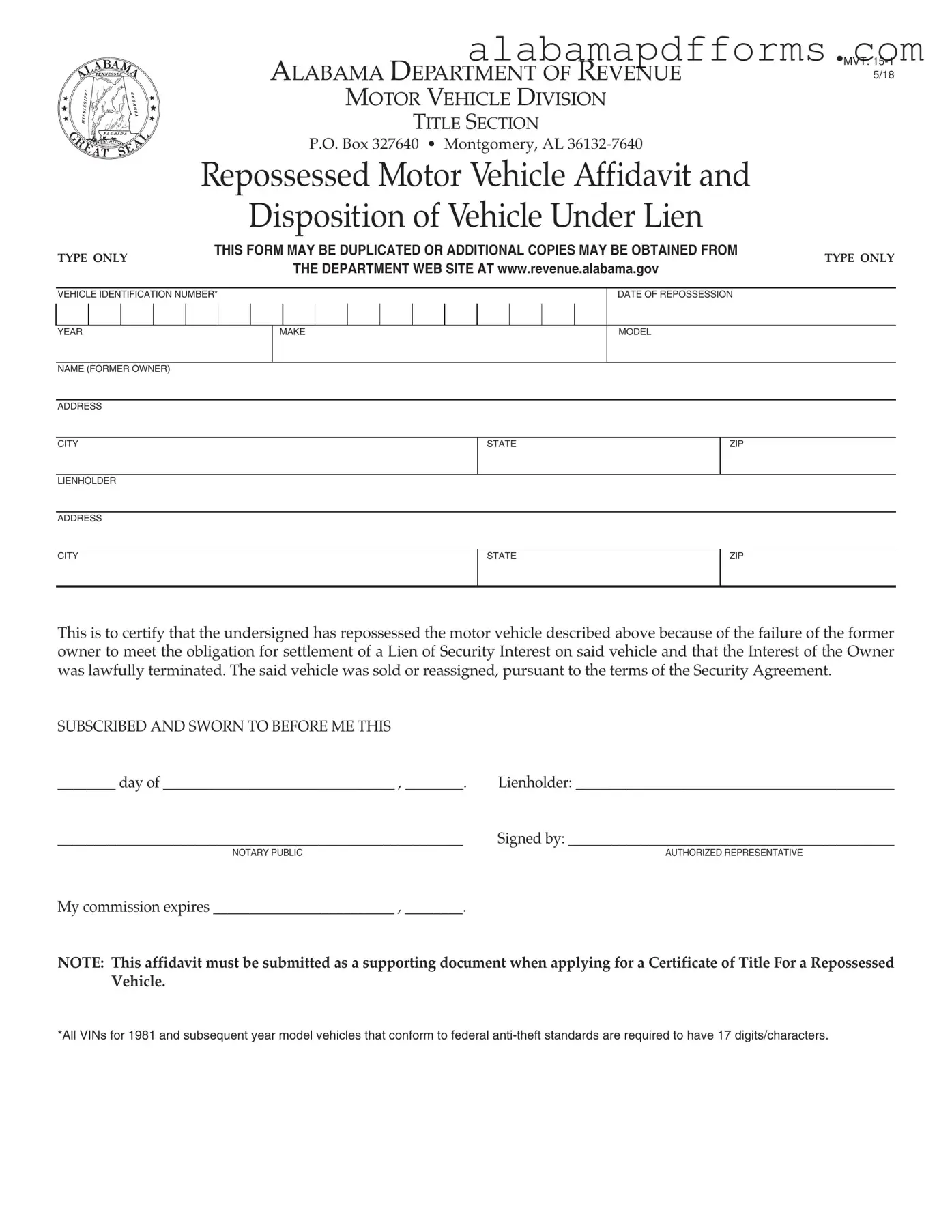The Alabama MVT 15-1 form, which serves as a Repossessed Motor Vehicle Affidavit, is quite similar to the Uniform Commercial Code (UCC) Financing Statement. Both documents are designed to establish a legal claim over a debtor's property, particularly in situations involving secured transactions. Just as the MVT 15-1 outlines the repossession of a vehicle due to non-payment, the UCC Financing Statement allows creditors to publicly declare their interest in personal property. This ensures that other potential creditors are aware of the existing lien, thus protecting the rights of the secured party in the event of the debtor's bankruptcy or insolvency.
Another document that shares similarities with the MVT 15-1 is the Notice of Default. This notice is typically sent by a lender to a borrower who has fallen behind on payments. Like the MVT 15-1, it serves as an official declaration of a breach of contract. Both documents aim to inform the affected parties about the status of the debt and the potential consequences of failing to remedy the situation. The Notice of Default is often a precursor to further action, such as repossession, mirroring the process outlined in the MVT 15-1.
In many ways, the legal landscape surrounding vehicle ownership and repossession mirrors the principles found in a Hold Harmless Agreement, which serves to protect one party from liabilities incurred by another during specific actions or services. Both types of documents are instrumental in defining and clarifying legal responsibilities, whether it be in vehicle transactions or agreements involving risk management.
The Bill of Sale is another relevant document. When a repossessed vehicle is sold, a Bill of Sale is usually generated to transfer ownership from the lienholder to the new buyer. Similar to the MVT 15-1, this document provides essential details about the vehicle, including the Vehicle Identification Number (VIN), make, model, and year. Both documents serve to formalize the change in ownership, ensuring that all parties are aware of the transaction and the legal implications involved.
The Affidavit of Title is also akin to the MVT 15-1. This document is often used to confirm ownership of a vehicle when the original title is lost or unavailable. Both affidavits provide a sworn statement regarding the vehicle’s ownership and the circumstances surrounding its title. While the MVT 15-1 specifically addresses repossession, the Affidavit of Title can be utilized in various situations, making it a versatile tool in the realm of vehicle ownership documentation.
Additionally, the Repossession Order is another document that aligns closely with the MVT 15-1. This order is typically issued by a court or authorized entity to allow a creditor to reclaim a vehicle after a default. Both documents serve to validate the repossession process, ensuring that it is conducted legally and in accordance with established protocols. The Repossession Order often precedes the completion of the MVT 15-1, as it provides the necessary legal backing for the repossession to occur.
Lastly, the Certificate of Title itself shares a connection with the MVT 15-1. Once the repossession and subsequent sale of the vehicle are completed, a new Certificate of Title is issued to the new owner. This document serves as the official proof of ownership, much like the MVT 15-1 serves as proof of the lienholder's right to repossess the vehicle. Both documents play crucial roles in establishing and transferring ownership, ensuring that all legal requirements are met in the process.

